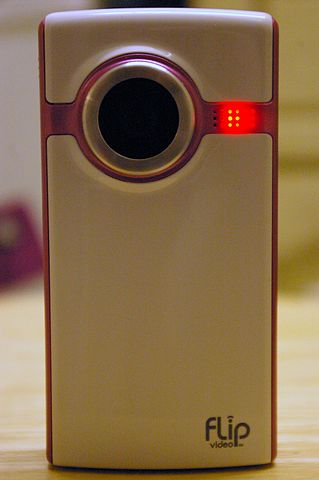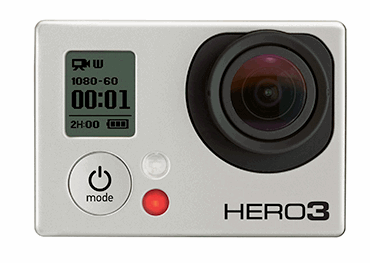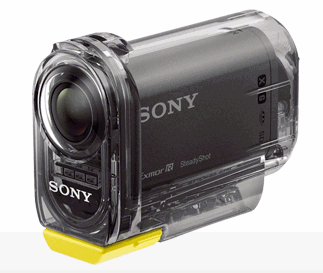
Remember the Flip video camera from 5 years ago? Simple and easy to use and able to feed the growing use of video on the Web. Cisco bought Flip for nearly $600M in March 2009. But two years later Cisco shutdown its Flip division as video came on board not only point+shoot as well as DSLR cameras but also appeared in smartphones.
The Flip cost between $150 and $225 for a camera capable of delivering 1280 x 780P at 24fps for anywhere between 30 minutes to 2 hours. The camera thrived on its ease of use and a growing segment of users who bought “accessories for the Flip Video camera including an underwater case, a tripod, a bicycle helmet attachment, and a wool case (Mino camcorders) or soft pouch (Flip UltraHD), a rechargeable battery replacement for the UltraHD (1 hr. AA rechargeable, 2 hr. AAA rechargeable lithium ion) and also an extension cable to connect the camera in hard to reach places.”
This was the Action Camera segment of adventurists who wanted to take either stills or videos of their expeditions on motorbiking, hang-gliding, parachuting, skin-diving, ice climbing, skateboarding, ski-ing or other X-Games like activities. Their priorities were different than what most video cameras were providing. Here are the adventurist priorities:
1)Rugged camera able to withstand both water and shuddering jolts during operation in a wide range of weather conditions;
2)Ample choice of mount accessories so the camera could be attached to helmet, handle bars, wrist, surfboard, wand, skateboard or other vehicle or projecting devices without fear that the camera will fall off;
3)The camera record both still images at a variety of intervals and video at frame rates from 20 to 200 frames per second and at screen sizes of 320 x 240 to 4ooo x 4000 in size;
4)The camera be able to record extreme wide angle yet close up to infinity for video frames or images;
More recently adventurists have started to look for more advanced features like image stabilization, WiFi based remote control, better low light recording, sound noise masking and a choice of field of view settings – most record at 170 degrees or nearly a fisheye setting.
Fortunately, a wide range of non traditional camera makers have responded to the market demand and are delivering Action Video Cameras [actually this is a misnomer because all of the cameras shown below offer both still and video modes of operation] at prices from $200 to $400. As we shall see below, many of the cameras also fulfill the adventurist requirements.
Contour+2

For $349.99 the Contour+2 delivers a fairly balanced range of Action Camera specifications.
1)Video specs:
Full HD – 1080p (1920 x 1080) @ 30/25fps
Tall HD – 960p (1280 x 960) @ 30/25fps
Action HD – 720p (1280 x 720) @ 60/50 or 30/25fps
Slow Motion – 480p (854 x 480) @ 120/100, 60/50, or 30/25fps
H264 codec recorded in mp4 format;
2)Still Mode: 5mPixel every 1, 3, 5, 10, 15, 20, 30, 45, or 60 sec;
3)Audio specs: AAC Audio Compression, External Mic Jack, Internal Mic
4)Lens: 270 degree rotation and laser alignment
5)Control: Top of camera easy on and off switch,Bluetooth module for iOS or Android mobile app controlof all camera settings and operations;
6)Battery: 2 to 2 1/2 hour recording; replaceable Li-ion batteries [$19.99 each];
7)Memory specs: 4GB micro SD card on board upto 32GB max;
8)Mount accessories: waterproof casing good to 60m, rotating handlebar mount, profile mount all in the box with others available;
9)Connectors: USB, microHDMI, plus GPS unit recording location and elevation, info added to frames & images and live displayable on Bluetooth connected mobile or USB+HDMI connected 3rd party display.
The Contour+2 has garnered very positive reviews from Engadget and CNET. However, other reviews found problems with the Contours mounts.
Sample video:


For $399.99, the GoPro Hero 3 Black Edition delivers some of the best Action Camera Video specs. The cameras light weight and small size makes [ 1.6 by 2.3 by 0.8 inches and 2.6 ounces ] it popular among model airplane flyers and adventurists looking to save camera weight and encumbrance. Here are the detailed specifications:
1)Video specs:
2160P – (3840 x 2160 at 19:9) @ 15/12fps
1524P – (2704 x 1524 at 16:9) @ 30/24fps
1440P – (1920 x 1440 at 4:3) @ 60/48/30fps
1080P – (1920 x 1080 at 16:9) @ 60/48/30/25fps
960P – (1280 x 720) @100/48fps
720P – (1280 x 720) @120/60fps
480P (854 x 480 at 16:9) @ 240fps;
All frame rates given are NTSC, PAL are slightly lower
H264 codec recorded in mp4 format;
2)Still Mode: 5/7/12mPixel every .5, 1, 2, 5, 10, 30, or 60 sec plus burst mode at 30 images/second and simultaneous video and still images at 720P, 1080P and 1440P;
3)Audio specs: AAC Audio Compression, Internal Mic
4)Lens: f2.8, 6-element aspherical with 3 Field Of View settings – narrow, medium and wide
5)Control: top and back of camera buttons with mini LCD screen,WiFi capable with iOS or Android mobile app control of camera settings and operations;
6)Battery: up to 1.5 hour recording depending on frame size and rate and use of WiFi control
7)Memory specs: no micro SD card provided but upto 64GB max;
8)Mount accessories: rotating handlebar mount, profile mount all in the box with others available;
9)Connectors: USB, microHDMI.
Sample video:


For $299.99, the Sony HDR-AS15 delivers some of the Sony video camera magic. Like the Hero3, the AS-15 is small and light – 3.23 x 0.96 x 1.85 inches and 3.05 ounces. But the video recording specs are
1)Video specs:
1080P – (1920 x 1080 at 16:9) @ 30fps
720P – (1280 x 720) @120/60/30fps
480P (854 x 480 at 16:9) @ 240fps;
All frame rates given are NTSC, PAL are slightly lower
H264 codec recorded in mpeg4 format;
2)Still Mode: 2mPixel every 5, 10, 30, or 60 sec plus burst mode at 30 images/second and simultaneous video and still images at 720P, 1080P and 1440P;
3)Audio specs: AAC Audio Compression, Internal Mic
4)Lens: F2.8, Carl Zeiss with FOV of 170degrees standard or 120 degrees with image stabilization working
5)Control: top and back of camera buttons with mini LCD screen,WiFi capable with iOS or Android mobile app control of camera settings and operations;
6)Battery: up to 2.5 hour recording depending on frame size and rate
7)Memory specs: no micro SD card provided but upto 32GB max;
8)Mount accessories: 2 adhesive mounts, waterproff casing secure to 60 meters;
9)Connectors: USB, microHDMI.
Sample video:

Summary and Lesson
This review is both an exercise and a lesson. The exercise is to find an action camera that can do both stills and video in a variety of challenging and rugged settings. The emphasis is less on calibrating and framing the images and more about being able to take them in various extreme conditions. The results is that with any of these three cameras I have found a huge potential kicker to photo creative juices. Imagine going to Toronto’s THEx with one of these Action Cameras mounted to a monopod or even a tether at night on the Midway. Imagine dynamic images!
The other lesson is how quickly the camera and overall gadget markets change. Apple appeared to have an insurmountable and dominant lead in smartphones and tablets. Now, Apple is playing catchup to Samsung, HTC, and others in the smartphone market while defending furiously its lead in tablets. The Flip camera reached a peak in 2007-2009 and 2 years later it was dead in the eyes of Cisco management. But one key segment of users, adventurists wanting to take a rugged camera on their expeditions to document them in photos and video had a need that some novice electronic gadget builders were able to fill – and very well. In the process they have rescued a segment of the video camera market from being rolled over by point+shoot, smartphone and DSLR video cameras.
For example as a web developer I rarely need more than 4-6mPixel images but I need a lot of images to choose from in order to get the defining shot. Likewise, I need video that provides unique points of view – like attached to a speeding motorboat, summer sail glider or snowboarders careening downhill. DSLR, point+shoot and even smartphone cameras often just do not fit at all in these situations. Thus video cameras, already having a 4K revival at the highend, are also reborn at the “point+shoot” video end as action cameras.
